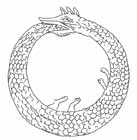Kundalini

Kundalini in Sanskrit means coiled up like a serpent at the base of the spine. In many cultures serpents stand for the life force itself. Why does the poor snake have to have all these metaphors and sexual fables imposed upon it?
Eastern and western, positive and negative, male and female, Genesis and the Fall, the "fiery flying serpent" and the cockatrice of Isaiah, the Greek Hydra, Norse and Hindu serpents, the Mayan and Aztec snakes, medicine and the Double Helix of DNA, J.K. Rowling’s House of Slytherin and the Basilisk… What is it about reptiles that inspires this ambivalence?
Then there's the icons below: the Caduceus and the Rod of Asclepius (the two are often confused), the ouroboros (infinity snake) and the infinity symbol:




The Caduceus was the wand of Hermes, showing two snakes entwined around the wand like a Double Helix. Along with Hermes' reputation as a thief and a trickster, it is ironic that this icon is frequently used to represent medicine nowadays. Technically it is the Rod of Asclepius that is the icon for medicine. Both are sexual images if you choose to see them that way, for example the Caduceus can be seen as a Plumed Serpent (c.f. Quetzalcoatl).
The ouroboros dates back to ancient Egyptian and Greek times before becoming important in Gnostic and Norse mythologies. Compare these with the Hindu (and Nazi) swastika or the Daoist Yin and Yang, which also convey the movement of cosmic energy.
